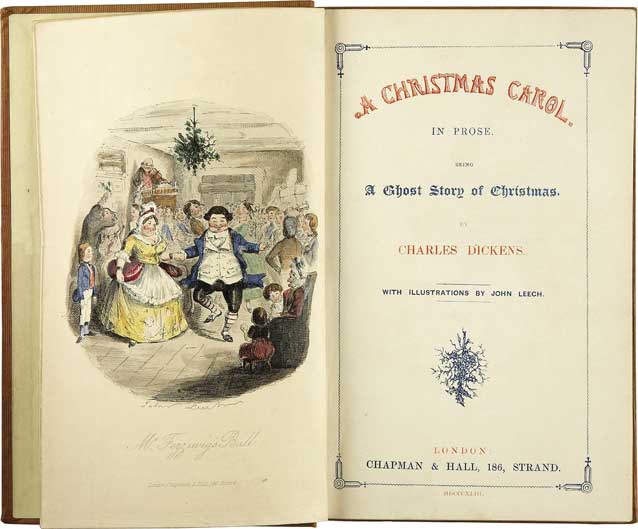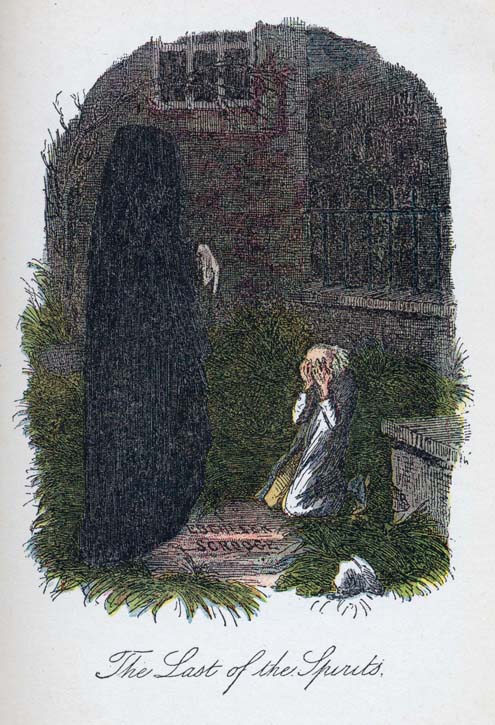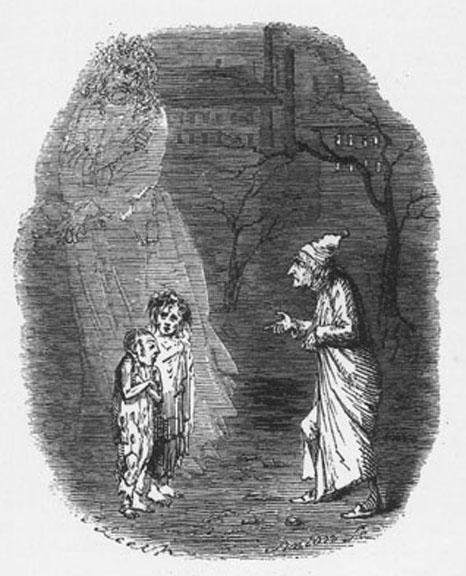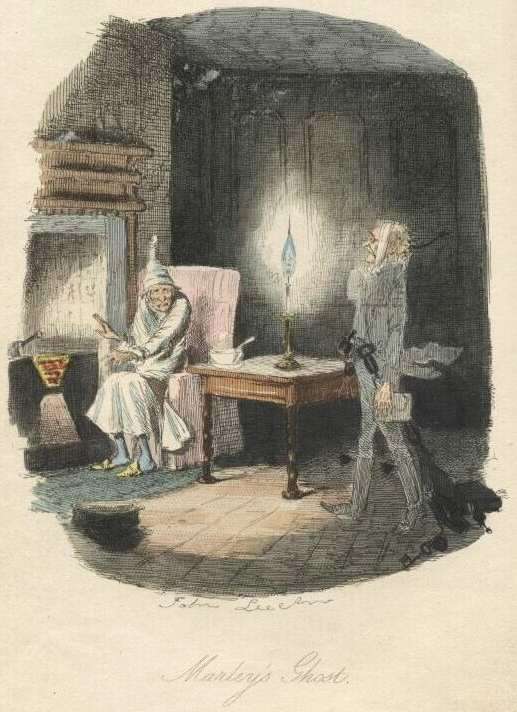Why A Christmas Carol Sings
‘How can a book written 167 years ago, at the beginning of the Victorian Age in England, still capture the imagination of a post-narrative, wireless America?’
By Michael Bruner
"There were more dances, and there were forfeits, and more dances, and there was cake, and there was negus, and there was a great piece of Cold Roast, and there was a great piece of Cold Boiled, and there were mincepies, and plenty of beer. But the great effect of the evening came after the Roast and Boiled, when the fiddler (an artful dog, mind! The sort of man who knew his business better than you or I could have told it him!) struck up 'Sir Roger de Coverley.' Then old Fezziwig stood out to dance with Mrs. Fezziwig. Top couple, too; with a good stiff piece of work cut out for them; three or four and twenty pair of partners; people who were not to be trifled with; people who would dance, and had no notion of walking." –-“A Christmas Carol,” by Charles Dickens
It's difficult to know which came first, Christmas or Dickens. With the possible exception of Jesus Christ, no one has had a greater influence on how we celebrate Christmas than Charles Dickens, and with the publication of his December masterpiece, the author and the season became inseparable--and to many, remain so. It is said that a young girl, upon learning of his death in 1870, declared, "What? Mr. Dickens dead? Will Father Christmas die too?" Before Dickens, English literature-- meaning, of course, the real English people doing and saying peculiar English things--didn't so much celebrate Christmas as observe it. G.K. Chesterton once remarked that there were those before Dickens, like Sirs Roger de Coverley and Walter Scott, who "sang in praise of" Christmas, but it was a feudal holiday they praised.* Dickens reinvented Christmas.
In Dickens's world, however, which straddled the Industrial Revolution and Victorian Age and saw the rise of the new working class in the nineteenth-century centers of urban squalor, life was too bleak, and wages too low, to celebrate much of anything. The Great Christmas Thaw began with the publication of “A Christmas Carol” in 1843. The same year, the first Christmas card was invented and sold--a thousand copies at a shilling a piece--while the new Royals, Albert and Victoria, introduced to England the tradition of the Christmas tree. But it was Dickens's book, which recast winter's favorite holiday as a return to childhood innocence and optimism, that changed the Christmas landscape.
The last of the three spirits shows Scrooge the future that awaits him. Hand-colored steel engraving by John Leech for the first edition of Dickens’s A Christmas Carol, 1843.This is startling enough--that a book can reinvent a tradition. But how can one written 168 years ago, at the beginning of the Victorian Age in England, still capture the imagination of a post-narrative, wireless America? In an age when Image has replaced Story, and Sound Bite has replaced Reasonable Discourse--bringing with them the commoditizing of beauty and the death of a genuine American aesthetic--how is it that we are still beguiled by the charms of this story? (I speak here only of the book itself. For those who have only seen a production but not read the book, it must be stated that the book is better--far better--than any of the dozen or more film and television adaptations. I've not seen the new Kelsey Grammer musical version, but the phrase "Scrooge's real love interest" in the playbill's synopsis doesn't provide much hope.) What is this story's particular alchemy? What, in other words, makes “A Christmas Carol” sing, particularly in America? Two things: the art of storytelling, of which Dickens is a master, and which allows the story to transcend culture; and the particular echoes of the story that ring in American ears, allowing us to reexamine our notions of what it means to be American.
The Art of Storytelling
“A Christmas Carol” finds its soul, first of all, as a ghost story, with the odd twist that it is a Christmas ghost story, a rather strange contrast. (In fact, the story's original subtitle was "Being a Ghost Story of Christmas.") Contrasts add texture and weight to a story, but contrasts alone are mere trifles. They must create a tension, which means they must be balanced in some way, and the real genius comes in that balancing act. Dickens got it exactly right. The first line of the book tells us that Marley is dead, and just so we're sure, the author reiterates three more times on the first page that Marley is dead. What an odd way to start a Christmas story. What a brilliant way to start one. Dickens understood that only an unorthodox retelling of this old tradition would wrest it free from its torpor. More to the point, he understood that nothing is more shockingly alive than something that ought to be dead. And only something alive, like Marley's ghost, could resuscitate something dead, like Scrooge. It was a stroke of genius. Another contrast, and perhaps the most obvious one, is the holiday itself, a celebration of light at the darkest time of year, of warmth at the coldest. Once again, Dickens exploits this brilliantly. The juxtaposing scenes of light and dark come at the reader so often and so quickly that they create an almost strobe light-like effect:
Meanwhile the fog and darkness thickened so, that people ran about with flaring links, proffering their services to go before horses in carriages, and conduct them on their way. The ancient tower of a church, whose gruff old bell was always peeping slyly down at Scrooge out of a gothic window in the wall, became invisible, and struck the hours and quarters in the clouds, with tremulous vibrations afterwards as if its teeth were chattering in its frozen head up there. The cold became intense. In the main street at the corner of the court, some labourers were repairing the gaspipes, and had lighted a great fire in a brazier, round which a party of ragged men and boys were gathered: warming their hands and winking their eyes before the blaze in rapture. The waterplug being left in solitude, its overflowings sullenly congealed, and turned to misanthropic ice. The brightness of the shops where holly sprigs and berries crackled in the lamp heat of the windows made pale faces ruddy as they passed.
There are countless other contrasts: life and death, remembering and forgetting, company and loneliness, kindness and bitterness, stinginess and generosity. The entire story, in fact, becomes a study of contrasts. But the high inducement of Dickens's storytelling only begins there.
Ignorance and Want, the orphans revealed to Scrooge by the second of the three spirits. Illustration by John Leech for the original 1843 edition of Charles Dickens’s A Christmas Carol. Scanned image by Philip V. Allingham, The Victorian WebThe story has great movement, also, and by this I do not mean simply that it moves--though it does, with Promethean energy. I mean to say that Dickens jumps the tracks of grammar and syntax onto another dimension. He does not show, as opposed to merely tell; he does, as opposed to merely show. How is this possible? I can make sense of it only in terms of a chemical phenomenon known as latent heat, which is externally supplied energy that is released or absorbed during a change of state of the mass of an object. It's as if the raw mental energy that Dickens expended in writing the words on the page is transferred to the reader in the act of reading them, as in the following passage:
But now a knocking at the door was heard, and such a rush immediately ensued that she with laughing face and plundered dress was borne towards it in the centre of a flushed and boisterous group, just in time to greet the father, who came home attended by a man laden with Christmas toys and presents. Then the shouting and the struggling, and the onslaught that was made on the defenseless porter! The scaling him, with chairs for ladders to dive into his pockets, despoil him of brown-paper parcels, hold on tight by his cravat, hug him round the neck, pommel his back, and kick his legs in irrepressible affection! The shouts of wonder and delight with which the development of every package was received! The terrible announcement that the baby had been taken in the act of putting a doll's fryingpan into his mouth, and was more than suspected of having swallowed a fictitious turkey, glued on the wooden platter! The immense relief of finding this a false alarm! The joy, and gratitude, and ecstasy! It is enough that, by degrees, the children and their emotions got out of the parlour, and, by one stair at a time, up to the top of the house, where they went to bed, and so subsided.
It takes an enormous amount of energy to write such lines, and yet, when reading them, a proportionate amount of energy is produced in the reader. I am invigorated, not enervated, when I finish this passage. And it is not simply a surfeit of exclamation marks that gives them this strange vitality. It is his choice of words, the precise placement of punctuation, the organic rhythm of the names, the repetition of words and phrases, the precise architecture of his sentences, the arcs within arcs--the veritable flying buttresses--of syntax. What imbues Michelangelo's David with vitality? Is it the angles? The size? The light? The posture? Whatever it is, it is like unto “A Christmas Carol.” All genius works of art share the same trait, a trait that can only be called anima. In Dickens's case, the sheer power of his mental faculties, which translated over into the technical elements of his writing, imbued his stories with a prodigious amount of it.
Mark Twain once heard Dickens give a reading, and he wrote of the English author's brilliance:
I thought of the wonderful mechanism within [his head], the complex but exquisitely adjusted machinery that could create men and women, and put the breath of life into them and alter all their ways and actions, elevate them, degrade them, murder them, marry them, conduct them through good and evil, through joy and sorrow, on their long march from the cradle to the grave, and never lose its godship over them, never make a mistake! I almost imagined I could see the wheels and pulleys work. This was Dickens--Dickens!
And this from the author of Huckleberry Finn.
American Echoes in A Christmas Carol
America has an overdeveloped superego, generally referred to as evangelical Christianity, engaged in an epic struggle with an overdeveloped id, generally referred to as Hollywood. Some see this struggle as proof of America's schizophrenia. Others see it merely as a country struggling with an identity crisis. Either way, we live in a nation of deep division, and as a result, we cannot agree on a defining story. We could do worse than temporarily adopt “A Christmas Carol” as a place-holding narrative. There are lessons to be learned from this Yuletide tale.
Scrooge is driven by greed at the expense of charity and good will. He soon discovers, however, with some outside help, that this is a destructive path, not only for those around him but for himself. He has mistaken the business of profit for the business of life. The ghost of his former partner, Jacob Marley, reminds him of this:
"But you were always a good man of business, Jacob," faltered Scrooge, who now began to apply this to himself. "Business!" cried the Ghost, wringing his hands again. "Mankind was my business. The common welfare was my business; charity, mercy, forbearance, and benevolence, were, all, my business. The dealings of my trade were but a drop of water in the comprehensive ocean of my business!"
Marley’s Ghost, one of eight illustrations by John Leech (who also acted in Dickens’s amateur theatricals) for the first edition of A Christmas Carol, 1843Marley recognizes this a lifetime too late and must therefore wander the earth carrying a chain of all that represented his unbridled pursuit of wealth. Dickens is making a point: what we hoard for ourselves in this life, we must carry in the next, and for those of us who have accumulated much, it will be "a ponderous chain!"
We are told at the end of the story that Scrooge discovers that the essence, not only of Christmas but of life, is what the narrator calls the Total Abstinence Principle. In the midst of a season of materialistic mayhem, in a country of conspicuous wealth, perhaps this is a principle we would all do well to heed. I can only surmise that Dickens meant by this that it is more blessed to give than receive. Or perhaps he simply meant that it's more fun.
Dickens's “A Christmas Carol” will be around for awhile and will continue to sing, not simply because of Dickens's mastery as a storyteller, but because the story itself speaks to us precisely where we need to listen. And as long as it continues to do so, one can only hope that Christmas will be, as Scrooge's indefatigably happy nephew proclaims,
a good time: a kind, forgiving, charitable, pleasant time: the only time I know of, in the long calendar of the year, when men and women seem by one consent to open their shut-up hearts freely, and to think of people below them as if they really were fellow-passengers to the grave, and not another race of creatures bound on other journeys.
(*G. K. Chesterton, Criticisms & Appreciations of the Works of Charles Dickens. London: J.M. Dent, 1993.)
Michael Bruner is adjunct professor of English and religion at Azusa Pacific University in Azusa, California. He has just completed a project comparing Jefferson, Dickens, and Tolstoy's versions of the gospels. This essay was originally published in Perspectives: A Journal of Reformed Thought
Founder/Publisher/Editor: David McGee
Contributing Editors: Billy Altman, Laura Fissinger, Christopher Hill, Derk Richardson
Logo Design: John Mendelsohn (www.johnmendelsohn.com)
Website Design: Kieran McGee (www.kieranmcgee.com)
Staff Photographers: Audrey Harrod (Louisville, KY; www.flickr.com/audreyharrod), Alicia Zappier (New York)
E-mail: thebluegrassspecial@gmail.com
Mailing Address: David McGee, 201 W. 85 St.—5B, New York, NY 10024







